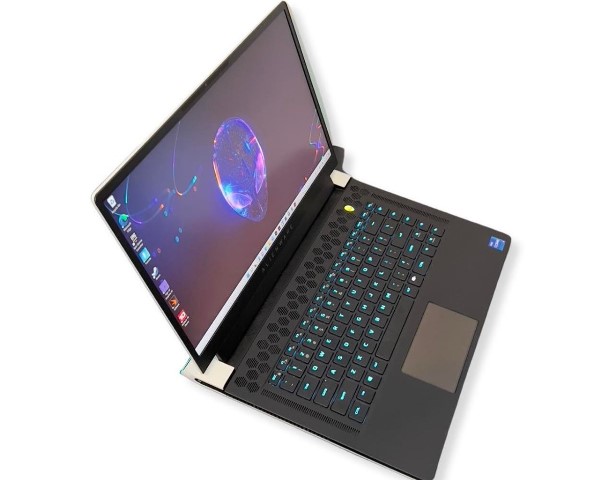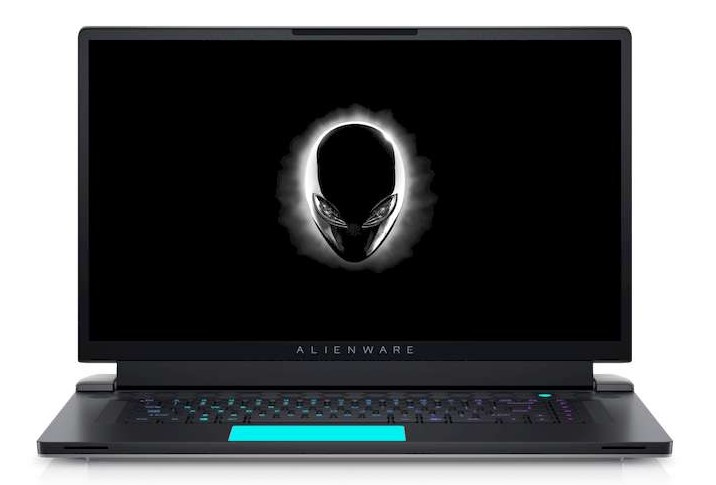Power Alone is no longer enough : Acer Predator Helios 300
Where the Helios 500 and 700 models are more reminiscent of semi-nomadic gaming stations that will rarely be moved given their size. Our Helios 300 intends to offer a slightly more versatile experience around a format 15 inches relatively compact. However, we remain on a performance-oriented machine. As evidenced by the Predator logo and the sound of the Formula 1 engine that greets us when we turn on the PC.
In fact, our test copy ships nothing less than a solid trio of components. Including Core i7-9750H, RTX 2060 and 2666 MHz DDR4 memory (16 GB).
Performance and versatility, therefore, should be the two pillars around which this Predator Helios 300 will be structured. Two pillars whose strength will depend for a lot on the cooling system, as we will find out.
See Also : Xbox Series X – Comfort and power to spare
Construction
Last week we were very friendly laughing at the unadventurous design of the MSI GE 65. Acer does not do much better with its Predator Helios 300. The manufacturer uses visual codes that we have already seen 1,000 times. A plain black dress enhanced by a few simple or raised highlights, vents on the back while ridges and aggressiveness, and several backlit elements.
The logo on the back of the screen shines with a pale bluish glow. While the keyboard benefits from RGB LEDs on all of its keys. Note, however, that the interest here is only aesthetic, since the lighting can only be configured on 4 zones and not key by key.
More generally, there are a lot of small details that betray a perfectible ergonomics compared to what we usually find on Asus or MSI productions of the same caliber. Thus, the Helios 300 can vary its operation (CPU / GPU couple and ventilation regime) according to 3 profiles.
Profile Acer Predator
Unfortunately, the call of these different profiles must necessarily go through the launch of the management software Predator Sense. A keyboard shortcut that would allow on-the-fly switching would have been much more convenient. Then, these profiles are all performance oriented, and in the absence of a passive or semi-passive mode. The fans will run continuously, around 2,000 rpm in light office work, and between 3,500 and 5 000 rpm under heavy load (encoding / video games).
Consequently, the noise pollution will be very moderate in the first case, or very strong in the second, between 46 dB for the “Normal” profile and 51 dB for the “Extreme” profile. With such values, the absence of a more reasonable operating mode is quite incomprehensible.
Especially since this option is offered on almost all machines on the market today. Acer does provide a few tools for creating a custom profile, but they too are performance oriented, and therefore limited in the possibilities they offer. We also notice that the increases or decreases in frequencies only affect the graphics circuit (GPU and memory). Profile changes are of no consequence for the processor, and again, it’s a shame,
Test For Heavy Load
When under heavy load, the core of the Helios 300 can reach 95 ° C, and generates hot spots at the base of the shell of 66 ° C (at the intersection of the CPU and GPU heat pipes, as shown in the thermal images) . Worse: this heat is difficult to dissipate, since the central zone of the keyboard can rise up to 50 ° C.
The diffusion effect does not extend to the user’s wrists, but when the hands glide over the affected parts, the heat is clearly noticeable.
Storage and Connection
The oversights do not only concern the management of the operation, judging by the endowment in terms of connectivity and storage. On the edges, we immediately note one absent: the SD card reader. Acer is therefore satisfied with the essentials with 3 USB 3.0 ports, an HDMI output, a combo jack to manage a headset, a USB type-C port, and an RJ45 socket. Which will be semi-removable and quite painful to use (its lower part closes to limit its thickness, making connections difficult).
Another major absence on our test copy: the possibility of connecting a 2.5-inch storage unit. The slot is there, but no SATA connector is available nearby. Either the latter exists, but the connecting sheet is absent from the models which do not require it, or the possibility of connection is shared with the nearest M.2 port.
In either case, it’s limiting. At least we will console ourselves with the fact that the chassis will be very easily removable, and that it will reveal. In addition to the two RAM memory slots, the Killer 1650X controller, synonymous with Wi-Fi 6 / Bluetooth 5.0 support.
Build Quality
Let’s hear it, the Acer Predator Helios boasts solid build quality. The different elements that make up the chassis are assembled with precision. And the back of the screen and the support surrounding the keyboard benefit from a welcome rigidity, which is due to the use of a metal alloy rather than plastic.
However, the whole is steeped in small functional renouncements that leave a taste of too little compared to the competition. Some will say: it does not matter if the performances are there. And luckily, you will see that Acer makes a rather very convincing copy at this level.
Performance
When it comes to laptops and performance, it’s hard to escape Intel and its Core i7-9750H. It is very logically on this component that Acer has made its choice and if it heats up a lot, it delivers the services that are expected of it. The CPU reaches a cruising frequency of around 2,950 MHz on average over 6 cores under H.265 encoding. In a game like Assassin’s Creed Odyssey , the frequency stabilizes at around 3,100 MHz instead, which is fine.
Therefore, there is not much to say, except that the Acer Helios 300 takes full advantage of its processor. Acer Helios 300 will give you some of the highest processing capacity on the market today.
For Games
As we pointed out above, Acer wanted to make its Helios 300 a benchmark machine in terms of gaming entertainment, by offering 3 graphics circuit overclocking profiles . In normal mode, the latter displays an average frequency of 1388 MHz, which is already high for an RTX 2060 GPU. In Fast mode, the GPU and its memory are offered a bonus of around 100 MHz.
Finally, the Extreme mode puts 100 MHz back on the table for everyone. However, with very marked increase in noise pollution. In terms of frame rate , the gains will obviously vary, with each game responding differently to increases in frequency. But, as an example, we went from 66 to 74 fps on average on our test sequence of The Witcher 3 while that of Assassin’s Creed Odyssey indicated 5 fps of gain, from 63 to 68. With these results, the Predator Helios 300 does as well as the MSI GE65 tested last week.
In terms of experience, Acer’s laptop PC will be just as comfortable on greedy games requiring a lot of GPU computing power. As it is on fast games that will make the CPU and GPU work together. As proof, the frame rate values we obtained on WRC 8 (98 fps in normal mode) or Overwatch (236 fps, still in normal mode). RTX requires, the Helios 300 will also be able to process ray tracing effects . However, it should be noted that the RTX 2060 remains limited to take advantage of these refinements. Which keep a very high cost in computing resources.
Screen for Acer Predator Helios 300
Let’s start with two important details: the first, on the Acer website, and unless we are mistaken. All Helios 300 models in RTX 2060 are delivered with a 144 Hz panel. This will not be the case with our test copy yet well marketed. And whose AHVA matte panel will only rise up to 60 Hz in refresh rate. And that’s a problem, as much of the competition has now incorporated faster displays.
Second point to note: our screen had a singular defect, particularly visible on blue colors, a sort of raster effect. This is undoubtedly a one-off problem (we sometimes receive pre-series products instead of commercial versions). But we recommend that you monitor the forums and customer reviews regarding this model, in case it is. fault would alert on a larger fault.
Need more 60 Hz
These two remarks aside, the screen of the Helios 300 remains average, on the verge of losing a star. Its calibration, without being catastrophic, does not shine with its fidelity (average delta E of 5.4). And no alternative profile is provided by the manufacturer. Contrast and brightness are also just average. But the biggest problem remains the afterglow. Measured at 28 ms, it may be felt on fast games even at 60 Hz. From a general point of view, we expected a much higher set, considering the specifications displayed (Full HD 60 Hz).
Audio for Acer Predator Helios 300
If the hardware part of the sound rendering does not come out of the usual canons (a Realtek circuit). The software solution that accompanies it surprises: it is the Wave MaxxAudio system. It will allow you to define equalization parameters, or to put the accent on certain sound elements, width of the scene, voice.
But considering what Nahimic is offering today, these options seem a bit limited. In addition, our measurements carried out on the headphone output indicate that the software or its drivers print a modification of the sound signal which we can only partially overcome. By choosing the speaker profile, rather than the headphone or microphone profiles. – headsets, when a device is connected. Once this obstacle is overcome, we benefit from a good power output, in line with current market standards.
Enough for listen
As for the speakers, they are often positioned on the side edges, slightly under the chassis, and closer to the user. Therefore, the quality of the broadcast sound remains dependent on the surface on which the machine is placed, and even in good conditions.
The rendering continues to lack breadth and focuses on the mids and high-mids, with correct stereophony.
Mobility / Autonomy
With a 15-inch format, a weight of 2.4 kg to which it will be necessary to add that of the power supply unit, i e 0.7 kg. The Predator Helios 300 will be those that will be transported quite easily in a backpack. And that we could possibly leave punctually. But it is obvious, and this is a common characteristic of most gaming laptop. That it will not be possible to leave it far from an AC outlet for too long.
The autonomy measured on our “Netflix” test is barely 4 h 30 min. Acer’s computer is therefore not very durable, being in the low range of its category. Here again, an operating mode geared towards saving energy would not have been too much.
Software Driver and Manual Guide
Software Driver Support for Acer Predator Helios 300
CONCLUSION
Is not a Greek god who wills. The Predator Helios 300 may show very convincing performance. It is lagging behind in too many aspects to pull itself out of the market average. The excessive heating of the chassis, the absence of a silent operating mode. The absence of an SD card reader, a choice of panel that would have deserved more care. Taken one by one, these elements do not necessarily seem decisive, but put end to end, they end up weighing heavy. In truth, the Helios 300 would probably have been a good match a year or two ago. But the current level of gaming laptops from Asus, MSI or Lenovo to name a few now leaves it little room to express oneself.


